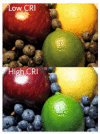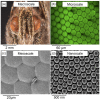Biomimetic Approaches to "Transparent" Photovoltaics: Current and Future Applications
- PMID: 36615373
- PMCID: PMC9822409
- DOI: 10.3390/molecules28010180
Biomimetic Approaches to "Transparent" Photovoltaics: Current and Future Applications
Abstract
There has been a surge in the interest for (semi)transparent photovoltaics (sTPVs) in recent years, since the more traditional, opaque, devices are not ideally suited for a variety of innovative applications spanning from smart and self-powered windows for buildings to those for vehicle integration. Additional requirements for these photovoltaic applications are a high conversion efficiency (despite the necessary compromise to achieve a degree of transparency) and an aesthetically pleasing design. One potential realm to explore in the attempt to meet such challenges is the biological world, where evolution has led to highly efficient and fascinating light-management structures. In this mini-review, we explore some of the biomimetic approaches that can be used to improve both transparent and semi-transparent photovoltaic cells, such as moth-eye inspired structures for improved performance and stability or tunable, coloured, and semi-transparent devices inspired by beetles' cuticles. Lastly, we briefly discuss possible future developments for bio-inspired and potentially bio-compatible sTPVs.
Keywords: biomimetic; semi-transparent photovoltaics; transparent photovoltaics.
Conflict of interest statement
The authors declare no conflict of interest.
Figures









References
-
- Hook M., Tang X. Depletion of fossil fuels and anthropogenic climate change-A review. Energy Policy. 2013;52:797–809. doi: 10.1016/j.enpol.2012.10.046. - DOI
-
- Foster R.A., Ghassemi M., Cota A., CrcnetBase . Solar Energy: Renewable Energy and the Environment. CRC Press; Boca Raton, FL, USA: 2010. p. 4.
-
- Moriarty P., Honnery D. What is the global potential for renewable energy? Renew. Sust. Energy Rev. 2012;16:244–252. doi: 10.1016/j.rser.2011.07.151. - DOI
-
- Chen H.S., Cong T.N., Yang W., Tan C.Q., Li Y.L., Ding Y.L. Progress in electrical energy storage system: A critical review. Prog. Nat. Sci. Mater. Int. 2009;19:291–312. doi: 10.1016/j.pnsc.2008.07.014. - DOI
-
- Heinstein P., Ballif C., Perret-Aebi L.E. Building integrated photovoltaics (BIPV): Review, potentials, barriers and myths. Green. 2013;3:125–156. doi: 10.1515/green-2013-0020. - DOI
Publication types
MeSH terms
Grants and funding
LinkOut - more resources
Full Text Sources

